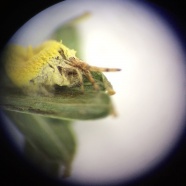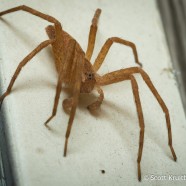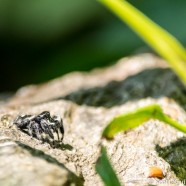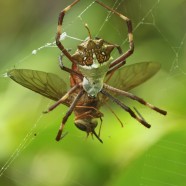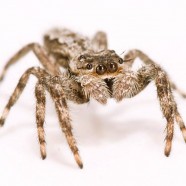Zombie Fungus?
During a recent Hemlock Woolly Adelgid survey, one of our volunteers found a little yellow blob attached to a hemlock twig. The mass was clearly not HWA, but curiosity prompted me to bring it back to the office for examination. A closer look under the microscope revealed that the blob actually consisted of a powdery fungus encapsulating a dead spider! After a bit of research, I came to suspect that it might be some sort of Cordyceps; a genus of parasitic fungi capable of taking control of an arthropod, thus directing it to navigate to a favorable position for the fungi’s spores to...
Read MoreCrawly, not Creepy!
Why do spiders have to be creepy, crawly creatures? Let’s go with crawly and not so creepy! We love all forms of wildlife. But it definitely fits the Halloween season…
Read MoreJumping Spider
This looks to be a jumping spider, though what species I cannot say for sure – I am no spider expert and this is as good of a look as I got from afar. It was hunting a local pond as so much more life is suddenly jumping out at this point of the spring. Why are “we” as a people so afraid of spiders anyway? With such a tiny percentage of all spiders having the ability to do us any potential harm we should probably stop worrying about them already! Scott Kruitbosch Conservation & Outreach
Read MoreOrb Weaver Spider (Argiope savignyi)
While walking trails and getting acclimated in Costa Rica today I came across this Orb Weaver spider (Argiope savignyi). It had recently captured some fly species in its web. I instantly recognized this spider because of a documented case of it eating a Proboscis Bat (Rhynchonycteris naso). It managed to encase the bat with its silk over the course of the day. The bat became tired and was able to be consumed eventually. Sean Graesser RTPI Affiliate
Read MoreHelpful jumping spider
This jumping spider seems like it is ready to pounce! And look at those eyes…they are not targeting you, though. Let’s thank it for being so helpful and grabbing all the flying insects we do not want in our homes that are far more likely to bite us.
Read More



